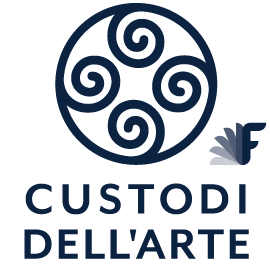

The Fish Market
The Fish Market
Riproduci traccia audio
Play audio track
Audio-Track abspielen
The Fish Market
Trascrizione traccia audio
Whether arriving at the fish market from “the canal” or “the little square”, the customer would immediately be bombarded by the call of the fishwives. Brilliant, affable and very talented, I met them all: Peppina, Angela, Maria, Tina, Libera, Rema, Iride, Marta, Caterina, Tilia, Diva, Giordana and Angiòla. Born “par vend’ e pes”, born to sell fish.
For over 80 years In this magical theatre, that is the fish market, a brilliant debut performance has been on stage where the central characters were actually the wives of the traders who own the “bènc de’ pes”, the fish stalls. Their astuteness was such that they could interpret the customer’s frame of mind and their willingness to spend the very moment they crossed the threshold. On first named terms, or even with nicknames, the customer would be called in a loud voice, almost a heartfelt appeal, to visit their counter. If the customer hesitated, perhaps because they didn’t have enough money (and at the time there were many families in financial difficulty), the long-anticipated enticement would come from the fishwives: “a t’faz un bon prézi… porta a cà una bèla zeina …a voi puli e benc” (“I’ll give you a good price, you can take home a nice dinner and I can have an empty counter”).
To the male customers they asked “Do you want to eat well this evening? Look at that beautiful fish, it’s still alive. I’ll give you a ridiculously low price, and your wife will be very happy when you bring home the mixed fish for frying.” There was also this same jovial tone, reserved for the longest standing customers, always in the local dialect, reminding them to Eat well this evening and afterwards they would feel good.
However, a different tone was reserved for the “lovely ladies”, those who arrived on Saturday afternoon for the catch of the day; with these “good customers”, the wives of the fishmongers would put on their best accent (or as it is put locally, they put on their “pointed shoes”), telling them stories with friendliness and promoting local recipes to the point of making them seem unique.
Being served from one counter rather than another nearby was an emotional issue, everyone had their own preferred fishmonger. There was the famous Peppina, who was first on the left as you entered on the canal side of the market. She specialised in preparing 13 to 14 types of fish, that sold specifically to make soup and broth. The gentlemen, and especially the lady customers, came from as far as Cesena and even Rimini just to buy fish here.
Then there was Marta, who had a fiery character to say the least: once, a lady arriving from Cesena stopped in front of her counter and asked: “Is this fish fresh?”. She quickly replied “No, l’è fraid” (No, It’s rotten!). This was a story that stayed in the history of the market. Marta lost a client, but she was given the satisfaction of having responded in the same haughty tone “d ‘la sgnora ad Cesàina” to the posh lady from Cesena.
This show was staged every day from two-thirty/three in the afternoon, when the fresh fish arrived, until six-thirty/seven, when remaining unsold fish would start to be sorted and then frozen.
For the people of this district of Cesenatico, known as the Mont, the fish market has always been the heart of daily life, as well as a place of great affection. There was no need for organised arrangements to meet one another, locals would spontaneously pitch up around the little square “d’la pscaria”, (of the fishmarket) which was once a dirt track. The older folk would enjoy a glass of wine in the two taverns overlooking the small square. We children, on the other hand, loved to roll a rusty hoop or play with a rag ball, but we also enjoyed listening to the chatter of the old people: you could hear all sorts of things, it was like being with your extended family, or that satisfied feeling of comfort when you dress up in familiar clothes.
During those times, the fulcrum of life was right here, even before the market was built, the fish trade was carried out on stalls in the square, sometimes the more thrifty traders would sell their fish from baskets laid on the ground; people lived as best they could, there was great poverty in those days.
In 1911 the town council finally built the fish market, on the interior were 10 sales counters, 5 on each side (facing the hills or facing the sea).
The small traders, to whom these stalls were assigned, paid rent; and the fish, landed in baskets, were auctioned to the traders on the port, (in those days the wholesale market had not been established). The traders then brought their fish to market to be sold to the public.
The town council also placed 2 stalls outside the market building, on the front of the Piazzetta delle Erbe. They were made available to the fishermen’s families for the sale of the “quota” due to each member of the crew. The wives of fishermen met the boats as they returned from sea, they weighed themselves fish from the “Mucchie” (a colloquial term which referred to this fish which was designated for the benefit of the fishing families), then they would return to these two small benches and sell their spoils to the residents of the village.
The fish trade here in Cesenatico experienced a flourishing period from the mid-1950s to the 1990s. After this the fish stocks dwindled and fishing began to decline from the busy trade it had once been.
In 2011 we celebrated the centenary of the Fish Market and also of one of the elder fishwives who worked there, Caterina Razzani. I, who was still employed by the Town’s Council, organised everything. Firstly, as there was no sign outside the market building, I went to a local blacksmith and after exchanging the usual pleasantries, I asked him to make me a sign, written in dialect”. The “Pscària 1911” sign can still be seen today hung the left wall of the market from the canal side. It reminds all of us in Cesenatico that this has always been the heart of the city, like a wonderful mother who embraces everyone.
Audio Track transcription
Whether arriving at the fish market from “the canal” or “the little square”, the customer would immediately be bombarded by the call of the fishwives. Brilliant, affable and very talented, I met them all: Peppina, Angela, Maria, Tina, Libera, Rema, Iride, Marta, Caterina, Tilia, Diva, Giordana and Angiòla. Born “par vend’ e pes”, born to sell fish.
For over 80 years In this magical theatre, that is the fish market, a brilliant debut performance has been on stage where the central characters were actually the wives of the traders who own the “bènc de’ pes”, the fish stalls. Their astuteness was such that they could interpret the customer’s frame of mind and their willingness to spend the very moment they crossed the threshold. On first named terms, or even with nicknames, the customer would be called in a loud voice, almost a heartfelt appeal, to visit their counter. If the customer hesitated, perhaps because they didn’t have enough money (and at the time there were many families in financial difficulty), the long-anticipated enticement would come from the fishwives: “a t’faz un bon prézi… porta a cà una bèla zeina …a voi puli e benc” (“I’ll give you a good price, you can take home a nice dinner and I can have an empty counter”).
To the male customers they asked “Do you want to eat well this evening? Look at that beautiful fish, it’s still alive. I’ll give you a ridiculously low price, and your wife will be very happy when you bring home the mixed fish for frying.” There was also this same jovial tone, reserved for the longest standing customers, always in the local dialect, reminding them to Eat well this evening and afterwards they would feel good.
However, a different tone was reserved for the “lovely ladies”, those who arrived on Saturday afternoon for the catch of the day; with these “good customers”, the wives of the fishmongers would put on their best accent (or as it is put locally, they put on their “pointed shoes”), telling them stories with friendliness and promoting local recipes to the point of making them seem unique.
Being served from one counter rather than another nearby was an emotional issue, everyone had their own preferred fishmonger. There was the famous Peppina, who was first on the left as you entered on the canal side of the market. She specialised in preparing 13 to 14 types of fish, that sold specifically to make soup and broth. The gentlemen, and especially the lady customers, came from as far as Cesena and even Rimini just to buy fish here.
Then there was Marta, who had a fiery character to say the least: once, a lady arriving from Cesena stopped in front of her counter and asked: “Is this fish fresh?”. She quickly replied “No, l’è fraid” (No, It’s rotten!). This was a story that stayed in the history of the market. Marta lost a client, but she was given the satisfaction of having responded in the same haughty tone “d ‘la sgnora ad Cesàina” to the posh lady from Cesena.
This show was staged every day from two-thirty/three in the afternoon, when the fresh fish arrived, until six-thirty/seven, when remaining unsold fish would start to be sorted and then frozen.
For the people of this district of Cesenatico, known as the Mont, the fish market has always been the heart of daily life, as well as a place of great affection. There was no need for organised arrangements to meet one another, locals would spontaneously pitch up around the little square “d’la pscaria”, (of the fishmarket) which was once a dirt track. The older folk would enjoy a glass of wine in the two taverns overlooking the small square. We children, on the other hand, loved to roll a rusty hoop or play with a rag ball, but we also enjoyed listening to the chatter of the old people: you could hear all sorts of things, it was like being with your extended family, or that satisfied feeling of comfort when you dress up in familiar clothes.
During those times, the fulcrum of life was right here, even before the market was built, the fish trade was carried out on stalls in the square, sometimes the more thrifty traders would sell their fish from baskets laid on the ground; people lived as best they could, there was great poverty in those days.
In 1911 the town council finally built the fish market, on the interior were 10 sales counters, 5 on each side (facing the hills or facing the sea).
The small traders, to whom these stalls were assigned, paid rent; and the fish, landed in baskets, were auctioned to the traders on the port, (in those days the wholesale market had not been established). The traders then brought their fish to market to be sold to the public.
The town council also placed 2 stalls outside the market building, on the front of the Piazzetta delle Erbe. They were made available to the fishermen’s families for the sale of the “quota” due to each member of the crew. The wives of fishermen met the boats as they returned from sea, they weighed themselves fish from the “Mucchie” (a colloquial term which referred to this fish which was designated for the benefit of the fishing families), then they would return to these two small benches and sell their spoils to the residents of the village.
The fish trade here in Cesenatico experienced a flourishing period from the mid-1950s to the 1990s. After this the fish stocks dwindled and fishing began to decline from the busy trade it had once been.
In 2011 we celebrated the centenary of the Fish Market and also of one of the elder fishwives who worked there, Caterina Razzani. I, who was still employed by the Town’s Council, organised everything. Firstly, as there was no sign outside the market building, I went to a local blacksmith and after exchanging the usual pleasantries, I asked him to make me a sign, written in dialect”. The “Pscària 1911” sign can still be seen today hung the left wall of the market from the canal side. It reminds all of us in Cesenatico that this has always been the heart of the city, like a wonderful mother who embraces everyone.
Audiotrack-Text
Whether arriving at the fish market from “the canal” or “the little square”, the customer would immediately be bombarded by the call of the fishwives. Brilliant, affable and very talented, I met them all: Peppina, Angela, Maria, Tina, Libera, Rema, Iride, Marta, Caterina, Tilia, Diva, Giordana and Angiòla. Born “par vend’ e pes”, born to sell fish.
For over 80 years In this magical theatre, that is the fish market, a brilliant debut performance has been on stage where the central characters were actually the wives of the traders who own the “bènc de’ pes”, the fish stalls. Their astuteness was such that they could interpret the customer’s frame of mind and their willingness to spend the very moment they crossed the threshold. On first named terms, or even with nicknames, the customer would be called in a loud voice, almost a heartfelt appeal, to visit their counter. If the customer hesitated, perhaps because they didn’t have enough money (and at the time there were many families in financial difficulty), the long-anticipated enticement would come from the fishwives: “a t’faz un bon prézi… porta a cà una bèla zeina …a voi puli e benc” (“I’ll give you a good price, you can take home a nice dinner and I can have an empty counter”).
To the male customers they asked “Do you want to eat well this evening? Look at that beautiful fish, it’s still alive. I’ll give you a ridiculously low price, and your wife will be very happy when you bring home the mixed fish for frying.” There was also this same jovial tone, reserved for the longest standing customers, always in the local dialect, reminding them to Eat well this evening and afterwards they would feel good.
However, a different tone was reserved for the “lovely ladies”, those who arrived on Saturday afternoon for the catch of the day; with these “good customers”, the wives of the fishmongers would put on their best accent (or as it is put locally, they put on their “pointed shoes”), telling them stories with friendliness and promoting local recipes to the point of making them seem unique.
Being served from one counter rather than another nearby was an emotional issue, everyone had their own preferred fishmonger. There was the famous Peppina, who was first on the left as you entered on the canal side of the market. She specialised in preparing 13 to 14 types of fish, that sold specifically to make soup and broth. The gentlemen, and especially the lady customers, came from as far as Cesena and even Rimini just to buy fish here.
Then there was Marta, who had a fiery character to say the least: once, a lady arriving from Cesena stopped in front of her counter and asked: “Is this fish fresh?”. She quickly replied “No, l’è fraid” (No, It’s rotten!). This was a story that stayed in the history of the market. Marta lost a client, but she was given the satisfaction of having responded in the same haughty tone “d ‘la sgnora ad Cesàina” to the posh lady from Cesena.
This show was staged every day from two-thirty/three in the afternoon, when the fresh fish arrived, until six-thirty/seven, when remaining unsold fish would start to be sorted and then frozen.
For the people of this district of Cesenatico, known as the Mont, the fish market has always been the heart of daily life, as well as a place of great affection. There was no need for organised arrangements to meet one another, locals would spontaneously pitch up around the little square “d’la pscaria”, (of the fishmarket) which was once a dirt track. The older folk would enjoy a glass of wine in the two taverns overlooking the small square. We children, on the other hand, loved to roll a rusty hoop or play with a rag ball, but we also enjoyed listening to the chatter of the old people: you could hear all sorts of things, it was like being with your extended family, or that satisfied feeling of comfort when you dress up in familiar clothes.
During those times, the fulcrum of life was right here, even before the market was built, the fish trade was carried out on stalls in the square, sometimes the more thrifty traders would sell their fish from baskets laid on the ground; people lived as best they could, there was great poverty in those days.
In 1911 the town council finally built the fish market, on the interior were 10 sales counters, 5 on each side (facing the hills or facing the sea).
The small traders, to whom these stalls were assigned, paid rent; and the fish, landed in baskets, were auctioned to the traders on the port, (in those days the wholesale market had not been established). The traders then brought their fish to market to be sold to the public.
The town council also placed 2 stalls outside the market building, on the front of the Piazzetta delle Erbe. They were made available to the fishermen’s families for the sale of the “quota” due to each member of the crew. The wives of fishermen met the boats as they returned from sea, they weighed themselves fish from the “Mucchie” (a colloquial term which referred to this fish which was designated for the benefit of the fishing families), then they would return to these two small benches and sell their spoils to the residents of the village.
The fish trade here in Cesenatico experienced a flourishing period from the mid-1950s to the 1990s. After this the fish stocks dwindled and fishing began to decline from the busy trade it had once been.
In 2011 we celebrated the centenary of the Fish Market and also of one of the elder fishwives who worked there, Caterina Razzani. I, who was still employed by the Town’s Council, organised everything. Firstly, as there was no sign outside the market building, I went to a local blacksmith and after exchanging the usual pleasantries, I asked him to make me a sign, written in dialect”. The “Pscària 1911” sign can still be seen today hung the left wall of the market from the canal side. It reminds all of us in Cesenatico that this has always been the heart of the city, like a wonderful mother who embraces everyone.
Narrato da
Narrated by
Mehr Infos



